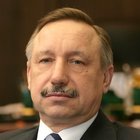A new icebreaker is being built at the Baltic Shipyard on the order of State Corporation Rosatom. It is the fifth Project 22220 nuclear-powered vessel. These nuclear icebreakers are the world’s largest and most powerful vessels designed to ensure year-round navigation in the Arctic.
During the event, Minister of Industry and Trade Anton Alikhanov and Director General of Rosatom Alexei Likhachev delivered reports.
The ceremony was also attended by Minister of Transport Roman Starovoit, Presidential Plenipotentiary Envoy to the Northwestern Federal District Alexander Gutsan, Head of the Presidential Directorate for National Maritime Policy Sergei Vakhrukov, St Petersburg Governor Alexander Beglov, Governor of the Chukotka Autonomous Area Vladislav Kuznetsov, Chair of the Council of the Sirius Federal Territory and Head of the Talent and Success Educational Foundation Yelena Shmeleva, Director General of the Baltic Shipyard Alexander Konovalov, and Director General of United Shipbuilding Corporation Andrei Puchkov.
* * *
President of Russia Vladimir Putin: Colleagues, good afternoon! It is a pleasure to see you all.
Today marks a major and meaningful event related to the large-scale development of the Arctic, Siberia, and the Russian Far East.
Today in St Petersburg, a new nuclear icebreaker Chukotka will be set afloat from the slipways of the Baltic Shipyard. I congratulate everyone on this significant milestone in the history of our modern icebreaker fleet. And, of course, I thank the specialists involved in this work for their dedication and high professionalism.
The nuclear icebreaker Chukotka will be the fourth serial icebreaker built under this project. One icebreaker was built before that series had been launched. Two more ships of the same class, Yakutia and Leningrad, are under construction at the Baltic Shipyard.
Next year, as agreed, icebreaker Stalingrad of the same series should be laid down. In addition, the next-generation nuclear icebreaker Leader, the most powerful so far, is being built at Zvezda shipyard in the Far East.
The construction of these powerful modern vessels is yet another embodiment of Russia’s industrial, scientific, technological and human resources potential. It is on the basis of domestic technologies and breakthrough scientific solutions that the national economy should develop.
I would like to repeat that our plans to develop our Arctic territories and to increase cargo traffic along the Northern Sea Route rely on expanding Russia's icebreaker fleet.
As you know, we have ambitious plans in this area. There is a great deal to be done. In this context, I suggest holding a special meeting on this subject, thoroughly preparing and comprehensively discussing all aspects of advanced development of the Northern Sea Route, so that we find concrete practical solutions. This is exactly how we approached the development of the Eastern Operating Domain and the modernisation of the Baikal-Amur and Trans-Siberian railways.
In particular, we will need to consider options to create a more efficient pricing model for icebreaker freight transit, so that more carriers and shippers can afford such services, especially since both Russian and foreign companies are showing more and more interest in this route with each passing year, and I am sure this interest will only grow.
Overall, we will need to seriously improve the safety and reliability of shipping in that region. To this end, we will continue to improve the quality of satellite navigation and communication, ice monitoring, upgrade infrastructure of Arctic ports and build the necessary railway access routes to them. In particular, we will need to expand and increase the capacity of nearby and distant railway access routes to the Murmansk Transport Hub, and to build a Northern Latitudinal Railway with potential extensions to the ports of Yamal, Taimyr and the north of the Krasnoyarsk Territory.
In conclusion, I would like to wish good health to our shipbuilders and other participants of our Arctic projects and with them new major achievements for the benefit of Russia.
Minister of Industry and Trade Anton Alikhanov has the floor. Go ahead, please.
Excerpts from transcript of ceremony for launching nuclear-powered icebreaker Chukotka
Minister of Industry and Trade Anton Alikhanov: Our shipbuilders continue to augment the Russian icebreaker fleet, which is the largest globally. Since 2016, three new-generation nuclear-powered vessels – the Arktika, Sibir, and Ural – have been floated out from the Baltic Shipyard and are now working in the waters of the Northern Sea Route. Today, the Chukotka icebreaker will join this group as we are floating it out. In the coming weeks, we anticipate the delivery of another icebreaker, the Yakutia, which is more than 95 percent complete.
As you have already stated, Mr President, the Leningrad and Stalingrad nuclear-powered icebreakers will continue this series, with the flagship being the unique 120-megawatt nuclear-powered icebreaker Rossiya of the Lider class. Its construction is currently underway at Zvezda shipyard in the Primorye Territory, and an option to place orders for four diesel-electric icebreakers at this facility is being considered. Commissioning of these vessels will free up more powerful nuclear-powered ships to be used in the eastern sector of the Northern Sea Route where ice conditions are more severe.
Simultaneously, to fully utilise our main maritime route, we require a sovereign heavy-lift cargo fleet, including gas tankers, bulk cargo ships, container vessels, dry-cargo ships, and oil and LNG tankers. The aforementioned Zvezda shipyard is engaged in the construction of these vessels. Currently, the large tonnage order book stands at 26 vessels. Additionally, Zvezda's long-term plan until 2037 includes 92 ice-class cargo vessels to meet the needs of the Northern Sea Route.
Mr President, following your instructions to ensure a higher level of localisation and technological independence for our new fleet, we continue to develop production capabilities for critical shipboard equipment. We have allocated a separate subsidy for this purpose, under which 47 enterprises are designing 89 types of this new equipment. Starting next year, we will commence batch production of the initial items.
For the next three years, we have also allocated budgetary funds for these purposes, and we are independently developing and providing new mechanisms in the budget to stimulate demand for such critical shipboard equipment as we aim to enhance its competitiveness.
We are very grateful to our shipbuilders, particularly the staff of the Baltic Shipyard, for their outstanding work. Following maritime tradition, we have invited Yelena Shmeleva, Chair of the Council of the Sirius Federal Territory and a member of the Presidential Council for Science and Education, to become the godmother of the Chukotka icebreaker.
I would like to extend my gratitude to you, Mr President, on behalf of the entire industry, for your unwavering support for the full range of objectives that our shipyards are addressing today.
* * *
Director General of Rosatom Alexei Likhachev: Mr President, the new icebreaker’s onboard power plant, which is the heart of the ship, has two RITM-200 reactors, each with a capacity of 55 megawatts. Designed by our reactor engineers, including the OKBM Afrikantov design bureau in Nizhny Novgorod, these reactors are widely used on icebreakers. We plan to continue taking advantage of this technology to develop the Northern Sea Route. Furthermore, such units will be used for floating nuclear power plants; two of them are already under construction, on the order of the Baimsky mining and processing plant.
It is important to emphasise that Arctic projects, equipment for northern waters, are not the only modernisation projects in our portfolio; we are simultaneously developing what we call a tropical floating nuclear power plant for friendly countries in Africa and Southeast Asia. In particular, new contracts to build them were secured during the BRICS summit.
It is very important for us to envisage, as part of the further development of shipbuilding, a serial production of floating nuclear power plants for Russian customers and Russian territories, as well as for our foreign partners.
Vladimir Putin: Thank you.
Mr Konovalov, I would like to ask you as the director of the plant, how is the work on the next projects going?
Director General of Baltic Shipyard Alexander Konovalov: We are working according to the approved schedules. Currently, we are at the assembly-manufacturing stage for the nuclear-powered icebreaker Leningrad. Work has started on the metal-water shielding tanks for the nuclear icebreaker Stalingrad. In general, we are meeting every deadline, keeping to the schedule. Today we expect to accelerate the portside turbine generator on the Yakutia to 3,000 rpm.
Vladimir Putin: Thank you.
I want to thank you and your entire staff for their work. I am sure that all plans will be implemented.
Alexander Konovalov: Thank you very much.
Andrei Puchkov: Mr President,
The fourth serial universal nuclear-powered icebreaker Chukotka, serial number 05712, Project 22220, is ready for launch. The certificate of readiness has been signed, the launching team is ready, the launching gear has been checked. I ask for permission to launch her.
Vladimir Putin: You have my permission.
(Ceremony for launching the icebreaker.)
Alexei Likhachev: Mr President,
Allow me to report about the development of the Northern Sea Route and our current plans for advancing it.
We have long awaited today’s launch of the Chukotka nuclear-powered icebreaker. It is extremely important for Atomflot, our company, which will turn 65 this December.
Mr President, thanks to your decision, in 2008 Atomflot became part of State Corporation Rosatom and has, over the years, become a powerful, growing, strategically important, and successful enterprise. However, Atomflot takes greatest pride in its team, polar seamen who conquer the Arctic expanses daily. There is no other team anywhere in the world with such experience and unique competencies.
In your opening remarks, you described well the dramatics of the nuclear icebreaker construction industry across the country. I would like to highlight a special goal: integrating the Yakutia icebreaker into the fleet by the end of this year. New icebreakers are essential for developing not just the transport routes, but the entire Arctic region. Since 2013, cargo traffic along the Northern Sea Route has increased nearly tenfold. This momentum continues, and this year we are also seeing record-high results.
Growth in transit in quite notable. More than three million tonnes of transit cargo have already been transported thanks to redirecting cargo from western to eastern routes, a 40 percent increase from last year.
We see a growing practical interest from friendly nations. We are working with the Government of the People’s Republic of China within a special subcommittee, and a Russian-Indian working group on the Northern Sea Route is operational as well. This collaboration is producing real results; there have been over 13 voyages between Russian and Chinese ports this year.
The advantage is clear. A container shipped from Shanghai via the Northern Sea Route reaches Moscow two weeks faster than through the Suez Canal. And, of course, we are working with our foreign partners on plans to build and operate container ships specifically for the Northern Sea Route.
Mr President,
Our strategic objective today is to begin round-the-clock navigation along the Northern Sea Route as soon as possible. The key component here is the icebreakers; not only we are waiting for them, the world is waiting for them.
From the bottom of my heart, I want to thank the Baltic ship-builders for the excellent work and express the hope that we will keep working the same way with respect to time, cost and quality. This is the only way – together, jointly – for us to succeed.
Mr President,
Let me express my gratitude for your attention, for the assignments that you gave on the further strategic development of the great Northern Sea Route. Under the guidance of the Presidential Executive Office, the Government of the Russian Federation, together with transport companies, together with companies operating in the Arctic, we are working on your instructions and will be ready to report to you soon on our development plans up to 2050.
Vladimir Putin: I congratulate you again. Russia has the largest icebreaking fleet in the world. This is natural, Russia is a northern country. We have 34 diesel icebreakers, seven nuclear-powered icebreakers, and there will also be the Yakutia, Chukotka, Leningrad and Stalingrad – 11 in all. And the Leader. In December, hopefully, we will raise the flag on the Yakutia nuclear-powered icebreaker and it will join Russia’s icebreaking fleet.
The year before last we carried 34 million tonnes along the Northern Sea Route, in 2023 – 36 million tonnes, this year it will be 37.6, somewhere around 38, and in 2030, I am sure, it will be over 100 million tonnes. These are ambitious plans, and their implementation will make a significant contribution to the development of Russia's transport infrastructure and make the Northern Sea Route very attractive both for the Russian carriers and our partners abroad.
I believe that the Northern Sea Route will only gain momentum year on year and not only because of the climate change, but also thanks to greater capabilities of the Russian icebreaker fleet.
I want to congratulate once again the shipbuilders – workers, engineers, scientists and specialists in most diverse fields – on today’s event. For the shipbuilders and the country as a whole it is a good and festive event. I am sure we will hold another such event at the end of this year and hoist the flag on another icebreaker, the Yakutia.
All the best! Thank you very much for your work.



















